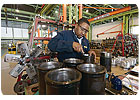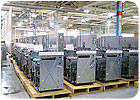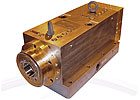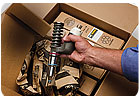
Waste not; want not. It’s a great concept. By eliminating-or at least minimizing-waste, we’ll never want for the essentials of life. This, of course, is what recycling is all about-using and then reusing our resources. To a certain extent, it’s even what lean manufacturing is all about-a never-ending quest to eliminate waste.
But while recycling focuses primarily on reclaiming materials such as metals and plastics for reprocessing and reuse, remanufacturing takes the “waste not; want not” concept to a higher-and more profitable-level. “Remanufacturing is the stealth business model,” says Ron Giuntini, advisor at The Remanufacturing Institute. “Profit margins on the sale of remanufactured goods can be as high as 40 percent.”
It’s also good for the environment. In his bookRemanufacturing: The Ultimate Form of Recycling, Rolf Steinhilper, Ph.D., chair for manufacturing and remanufacturing technology at the University of Bayreuth in Germany, writes: “The environmentally responsible industrial professional at once will recognize that remanufacturing is the key link in an integrated green technology chain to perform his new ‘cradle to grave’ product and recycling responsibilities and liabilities successfully.”
Remanufacturing is not merely overhaul or even extensive maintenance. At the Fifth International Congress on Environmentally Conscious Design and Manufacturing, which was held in June 1998 at the Rochester Institute of Technology, Robert T. Lund, Ph.D., of Boston University described remanufacturing as “an industrial process in which worn-out products are restored to like-new condition. Through a series of industrial processes in a factory environment, a discarded product is completely disassembled. Useable parts are cleaned, refurbished and put into inventory. Then the product is reassembled from the old parts (and where necessary, new parts) to produce a unit fully equivalent and sometimes superior in performance and expected lifetime to the original new product.”

More than 2.8 million copiers, printers and multifunction devices have been recovered through remanufacturing since 1991. Photo courtesy Xerox Corp.
First Came Car Parts
Remanufacturers have been “recycling” automotive parts for more than 80 years, according to the Automotive Parts Remanufacturers Association (APRA). It all began during World War II, when the tremendous need to reuse automotive and truck parts gave birth to the industry. Natural resources were scarce during wartime, and many of the resources we did have were going to the war effort. Rebuilding used parts met the demand for quality replacements. Today, APRA’s 1,000 member companies remanufacture virtually every component and system for cars and trucks.The economics are significant. Remanufactured components are 40 percent to 60 percent the cost of a new component. In the case of starters and alternators, for example, remanufactured units are about half the cost of a new unit. Steinhilper regards these two components as the “shooting stars” of remanufacturing. The annual volume of remanufactured starters and alternators-some 60 million units worldwide-is approximately equal to the volume of new car manufacturing. The only other parts remanufactured in similar quantities are some types of brake shoes.
The environmental benefits are also significant. APRA says the car parts remanufacturing industry helps the environment in numerous ways, including:
Energy conservation. Automotive and truck parts are kept out of the resmelting process longer. As a result, millions of barrels of oil or comparable forms of energy are saved.
Raw material conservation. Remanufacturing gives a product numerous lives instead of just one, thereby saving raw materials. Rebuilders annually save millions of tons of natural resources, such as iron, aluminum and copper.
Landfill space conservation. Landfills are spared from accepting millions of tons of metallic and nonmetallic waste because of the monetary value the industry places on parts. This value is referred to as a “core charge” and is returned to the source of the worn out parts, ensuring that parts are returned to be rebuilt.
Air pollution reduction. Keeping parts out of the resmelting process benefits the environment by reducing pollution generated by resmelting.

Remanufacturing reduces the life-cycle cost of precision spindles used on machine tools. Photo courtesy Setco
More Than Car Parts
Machine tools are the backbone of manufacturing, and the spindles on machining centers, grinding machines and turning machines live a hard life. Setco designs and builds precision spindles, slides and modules used in many industries, including automotive, aerospace, woodworking, mold making, stone cutting and general metalworking. The firm is also the largest spindle remanufacturing company in North America. The firm remanufactures its own spindles, but 80 percent of the spindles it remanufactures are built by other manufacturers.The key to remanufacturing at Setco is not just restoring the spindle to the original specifications, but also incorporating any design improvements since it was built, says Jeff Clark, Setco’s president. In addition, Setco often adds engineering improvements developed in house, whether the spindle was built by Setco or another firm. For example, bearing contamination is a major reason that spindles fail. To address this issue, Setco routinely installs its proprietary AirShield bearing seal on remanufactured spindles. This seal uses clean, dry shop air to back-pressurize a flexible lip seal and prevent contaminants from entering the spindle.
Belt-driven spindles are vulnerable to overtensioning, which bends the shaft and applies excessive radial stress to the rear spindle bearing. In the near future, Setco will offer a proprietary device that customers can use to tension the belt correctly and eliminate this cause of premature bearing failure. Spindle remanufacturing at Setco focuses on reducing life-cycle cost, Clark adds, and both this device and the AirShield help achieve that goal.
The ubiquitous copy machine is indispensable to virtually every business. Xerox Corp. introduced the photocopier in 1949. Today, the company is also a leader in protecting the environment profitably by remanufacturing copy machines. Speaking at The Assembly Summit last year, Daniel E. Banaszak described how new product manufacturing and recovered product remanufacturing are carried out simultaneously at Xerox. In the Xerox culture, sustainability is where social expectations, environmental challenges and financial performance overlap.
Banaszak, vice president of manufacturing at the company’s Webster, NY, facility, explained that remanufacturing is a key element of sustainability, and therefore new product design incorporates both modular architecture and the principles of design for remanufacturing.
Those efforts have paid off. The recycle rate is 96 percent for one of Xerox’s most predominant production platforms, and more than 2.8 million copiers, printers and multifunction devices have been recovered through remanufacturing since 1991.
Caterpillar Inc. is a leading proponent of remanufacturing. Caterpillar’s Remanufacturing and Sustainable Solutions Div., known as Cat Reman, is one of the world’s largest remanufacturers, operating facilities in the United States, Europe, Mexico and China. Cat Reman operates as a one-for-one exchange in which end-of-life products are returned for a remanufactured product. These remanufactured units include starters, alternators, fuel injectors, hydraulic components, torque converters, electronic control units, water pumps, turbochargers, transmissions and complete diesel engines.
Cat Reman offers more than 6,000 part numbers ranging from 1-pound fuel nozzles to complete 16,500-pound engines. It remanufactures more than 2.3 million components annually and ships 9,000 units on an average day. Over the past five years, Cat Reman has grown from 800 employees and three facilities to more than 3,600 employees and 18 facilities. It has expanded geographically from two countries to seven countries, and nearly tripled its revenue.
The Cat Certified Rebuild (CCR) program goes further, making extensive use of remanufactured parts to give machines a second and third life. CCR is available for ten lines of large Cat machines, as well as certain commercial engines, and is the most extensive repair option for any machine.
The machine is stripped down to its bare frame and every part of every component is dismantled, examined, repaired or replaced, cleaned, reassembled and repainted. If necessary, the frame is straightened and reinforced. The remanufactured machine is as good as a new product and is backed by a warranty similar to the warranty that came with the new machine, yet this costs about half what the machine cost when it was new.
Caterpillar just announced a remanufacturing joint venture with China Yuchai to establish a company that will provide remanufacturing services for both Yuchai diesel engines and components, and certain Caterpillar diesel engines and components. The new company will provide state-of-the-art remanufactured engines and components to customers worldwide by leveraging remanufacturing technology through Cat Reman.

Cat Reman remanufactures more than 2.3 million components each year ranging from fuel injectors to complete diesel engines. Photo courtesy Caterpillar Inc.
Academia Plays a Role
One of the leading academic centers for research in remanufacturing is the National Center for Remanufacturing and Resource Recovery (NC3R), which is part of the Center for Integrated Manufacturing Studies at the Rochester Institute of Technology.Established in 1992, NC3R’s mission is to provide industry with advanced technologies and tools for efficient and cost-effective remanufacturing. NC3R does this through research programs focused on structural and material analysis, clean technologies, intelligent testing and diagnostic procedures, and design for remanufacturing.
NC3R also provides technical training to industry members through its education program, RemanU, which offers workshops in technology areas valuable to the remanufacturing industry. The objective of each workshop is to offer hands-on training that will provide immediate benefits to remanufacturers and their businesses.
It goes without saying that a product has to be manufactured before it can ever be remanufactured. But any product can only be remanufactured a finite number of times before it is no longer economically feasible or practical to do so. At that point, it must be replaced by a newly manufactured product. Thus, OEMs will never go away. In fact, in many cases, manufacturing and remanufacturing are mutually beneficial.